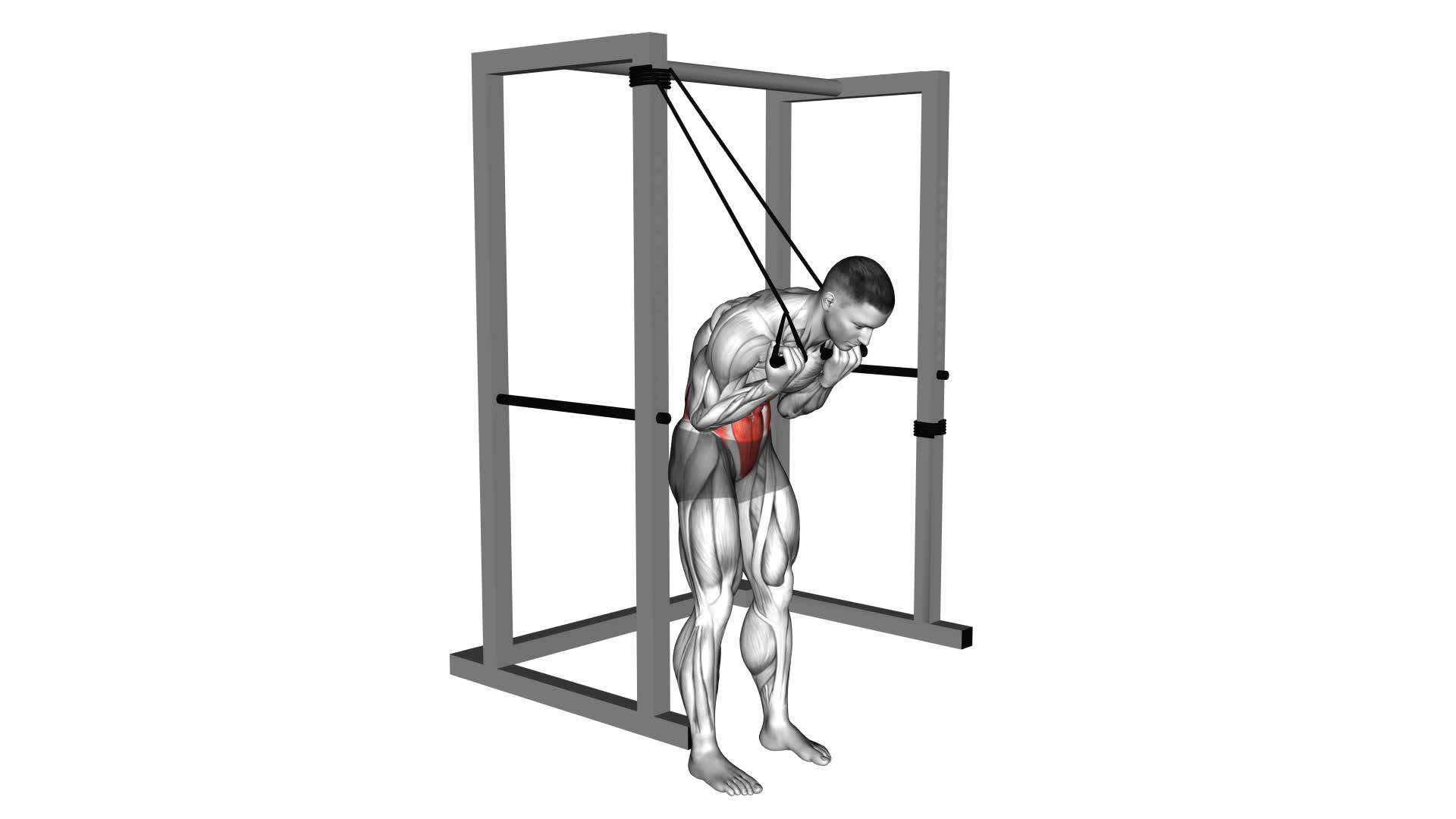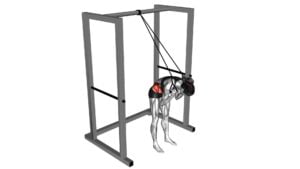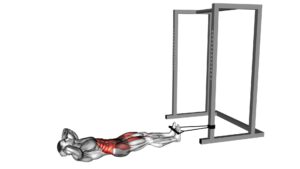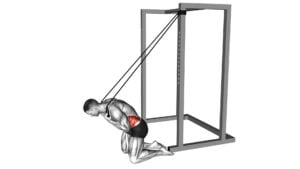Band Standing Crunch – Video Exercise Guide & Tips

Are you looking for an effective core exercise that you can do at home? Look no further than the Band Standing Crunch!
Watch This Exercise Video
In this video exercise guide, we'll show you the proper form and technique for this exercise, as well as variations to challenge your core. Plus, we'll share tips to help you get the most out of this workout.
Get ready to strengthen your abs and improve your balance with the Band Standing Crunch!
Key Takeaways
- Resistance bands are versatile and portable exercise equipment.
- Band standing crunch is an effective exercise for building strength and muscle tone.
- It is important to choose the right resistance level and maintain proper form and technique when using resistance bands.
- Additional accessories such as door anchors and ankle straps can enhance resistance band workouts.
Benefits of the Band Standing Crunch
To maximize the effectiveness of your band standing crunches, incorporating this exercise into your routine offers numerous benefits. Not only does it help in improving balance, but it also strengthens your abdominal muscles. The band standing crunch is a dynamic exercise that engages your core and stabilizer muscles, making it an excellent addition to your workout regimen.
By performing band standing crunches, you challenge your body to maintain stability while executing the movement. This helps improve your balance, as your core muscles work harder to keep you steady. Additionally, the resistance provided by the band adds an extra challenge to your abdominal muscles, leading to increased strength and tone.
Strong abdominal muscles aren't only aesthetically pleasing but also essential for overall functional fitness. Having a strong core improves your posture, reduces the risk of lower back pain, and enhances your athletic performance in activities like running, lifting, and playing sports.
Now that you understand the benefits of the band standing crunch, it's crucial to focus on proper form and technique to maximize your results and prevent injury.
Proper Form and Technique
To perform the band standing crunch with proper form and technique, focus on engaging your core and maintaining stability throughout the movement.
Start by attaching a resistance band to a sturdy anchor point at chest height. Stand with your feet shoulder-width apart, and hold the ends of the band with both hands, keeping your arms extended in front of you.
Begin the movement by pulling the band towards your chest, while simultaneously crunching your abs and bringing your knees towards your chest. Exhale as you perform the crunch and inhale as you return to the starting position.
It's important to avoid swinging or using momentum to complete the exercise. Common mistakes to watch out for include using your arms to pull the band instead of engaging your core, rounding your back, and letting your knees fall inward. Remember to maintain proper posture and alignment throughout the movement.
Modifications and progressions can be made based on your fitness level. If you're a beginner, you can start with a lighter resistance band or decrease the range of motion by not bringing your knees all the way up to your chest.
As you become more advanced, you can increase the resistance of the band or add a twist to the movement to further engage your obliques. Remember to always listen to your body and progress at a pace that feels challenging yet manageable.
Variations to Challenge Your Core
Increase the intensity of your core workout with these challenging variations. Take your band standing crunches to the next level by incorporating advanced modifications and specialized equipment. Here are three variations that will push your core muscles to their limits:
- Weighted Band Standing Crunch: Attach a weighted object, such as a medicine ball or dumbbell, to the end of your resistance band. As you perform the standing crunch, the added weight will increase the resistance and engage your core even more.
- Single-Leg Band Standing Crunch: Balance on one leg while performing the standing crunch. This variation not only challenges your core strength but also improves your balance and stability.
- Twisting Band Standing Crunch: As you crunch, add a twist to each side, engaging your obliques and challenging your core to stabilize and rotate.
To perform these advanced variations, you'll need a resistance band and any additional equipment mentioned. Make sure to choose a band with appropriate resistance for your fitness level. Always maintain proper form and technique to prevent injuries and get the most out of your workout.
These challenging variations will take your core workout to new heights and help you achieve a stronger and more defined midsection.
Tips for Getting the Most Out of This Exercise
To maximize the effectiveness of the band standing crunch exercise, focus on maintaining proper form and engaging your core muscles throughout the entire movement. This will ensure that you're targeting the right muscles and getting the most out of each repetition.
One common mistake to avoid is relying solely on your arms to pull the band down. Remember to use your abdominal muscles to initiate the movement and bring your knees up towards your chest. This will help to engage your core and increase the intensity of the exercise.
Another mistake is using too much momentum. It's important to perform the exercise in a controlled manner, focusing on the contraction of your abdominal muscles. Avoid swinging your body or rushing through the movement.
For beginners, there are a few modifications that can be made to make the exercise more accessible. You can start by using a lighter resistance band or even no band at all. This will allow you to focus on your form and build up strength before progressing to a heavier band. Additionally, you can start by performing the exercise with your feet flat on the ground instead of lifting them up. This will make it easier to engage your core and gradually progress to the full movement.
Incorporating the Band Standing Crunch Into Your Workout Routine
To incorporate the band standing crunch into your workout routine, start by including it as a core exercise during your strength training sessions. Here are a few tips to help you make the most out of this exercise:
- Standing crunch modifications: If you find it difficult to perform the standing crunch with a band, you can start by practicing the movement without the band first. Once you feel comfortable, you can gradually add resistance by incorporating the band.
- Integrating bands in core workouts: Bands are a great tool for adding resistance and targeting your core muscles. In addition to the band standing crunch, you can also incorporate bands into exercises like standing oblique crunches, standing woodchoppers, and standing Russian twists. These exercises will help you strengthen your abs, obliques, and lower back.
- Vary the resistance: Bands come in different levels of resistance, so make sure to choose the appropriate one for your fitness level. You can start with a lighter band and gradually increase the resistance as you get stronger.
Frequently Asked Questions
Can the Band Standing Crunch Be Modified for Beginners or Individuals With Limited Mobility?
Yes, the band standing crunch can be modified for beginners or individuals with limited mobility. By using a lighter resistance band or adjusting the tension, you can make the exercise more accessible.
Alternatively, you can also perform a seated version of the exercise, using the band to add resistance while sitting down.
These modifications allow individuals with limited mobility to still engage their core muscles and benefit from the exercise.
How Many Sets and Repetitions Should I Perform When Incorporating the Band Standing Crunch Into My Workout Routine?
When incorporating the band standing crunch into your workout routine, it's important to consider the number of sets and repetitions.
This exercise targets your core muscles, improves stability, and enhances overall strength.
To get the most out of this move, start with 2-3 sets of 10-12 repetitions. Remember to maintain proper form by keeping your back straight, engaging your abs, and squeezing your core as you crunch forward.
This will maximize the benefits and prevent injury.
Are There Any Alternative Exercises That Target the Same Muscle Groups as the Band Standing Crunch?
Looking for alternative exercises that target the same muscle groups as the band standing crunch? There are a few options you can try.
One alternative is the cable crunch, which uses a cable machine instead of a resistance band.
Another option is the stability ball crunch, which adds an element of balance and stability to the exercise.
If you're a beginner or have limited mobility, you can modify the exercise by performing a seated crunch or using a resistance band with handles instead.
Can the Band Standing Crunch Help With Improving Posture or Reducing Lower Back Pain?
To improve your posture and reduce lower back pain, the band standing crunch can be a beneficial exercise. By engaging your core muscles and strengthening your back, this exercise helps to support proper alignment and stability.
The resistance provided by the band adds an extra challenge, further enhancing the effectiveness of the exercise. Incorporating the band standing crunch into your routine can help you achieve better posture and alleviate lower back discomfort.
Is It Necessary to Use a Resistance Band for the Standing Crunch, or Can It Be Done Without Any Equipment?
You don't necessarily need to use a resistance band for the standing crunch. There are variations of the exercise that can be done without any equipment.
However, using a resistance band can provide additional benefits, such as increased resistance and muscle activation. It can help you challenge your muscles and make the exercise more effective.
Conclusion
Incorporating the band standing crunch into your workout routine is a great way to challenge your core and improve your overall strength. By following proper form and technique, you can maximize the benefits of this exercise.
There are also variations available to increase the difficulty level. Remember to listen to your body and start with a lighter resistance band if you're a beginner.
With consistency and dedication, you'll soon see improvements in your core strength and stability.

Author
Years ago, the spark of my life’s passion ignited in my mind the moment I stepped into the local gym for the first time. The inaugural bead of perspiration, the initial endeavor, the very first surge of endorphins, and a sense of pride that washed over me post-workout marked the beginning of my deep-seated interest in strength sports, fitness, and sports nutrition. This very curiosity blossomed rapidly into a profound fascination, propelling me to earn a Master’s degree in Physical Education from the Academy of Physical Education in Krakow, followed by a Sports Manager diploma from the Jagiellonian University. My journey of growth led me to gain more specialized qualifications, such as being a certified personal trainer with a focus on sports dietetics, a lifeguard, and an instructor for wellness and corrective gymnastics. Theoretical knowledge paired seamlessly with practical experience, reinforcing my belief that the transformation of individuals under my guidance was also a reflection of my personal growth. This belief holds true even today. Each day, I strive to push the boundaries and explore new realms. These realms gently elevate me to greater heights. The unique combination of passion for my field and the continuous quest for growth fuels my drive to break new ground.







